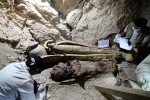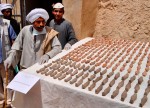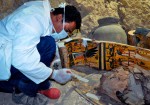 Archaeologists have discovered a tomb containing 10 coffins, eight mummies and more than 1,000 funerary statues in the Draa Abul Nagaa necropolis on the west bank of the Nile in Luxor. The team had to work hard to get to this point, removing more than 450 cubic meters of debris before reaching the door to the entrance of the tomb.
Archaeologists have discovered a tomb containing 10 coffins, eight mummies and more than 1,000 funerary statues in the Draa Abul Nagaa necropolis on the west bank of the Nile in Luxor. The team had to work hard to get to this point, removing more than 450 cubic meters of debris before reaching the door to the entrance of the tomb.
 The tomb is T-shaped with an open courtyard leading to a rectangular hall which is connected to a second chamber by a corridor. The longitudinal chamber held four painted wood coffins, the inner chamber six. In a shaft nine meters (30 feet) long, archaeologists found more Ushabti figurines, plus wooden masks and the handle from a sarcophagus lid.
The tomb is T-shaped with an open courtyard leading to a rectangular hall which is connected to a second chamber by a corridor. The longitudinal chamber held four painted wood coffins, the inner chamber six. In a shaft nine meters (30 feet) long, archaeologists found more Ushabti figurines, plus wooden masks and the handle from a sarcophagus lid.
 While the human remains are in varying states of decay — from intact linen-wrapped mummies to disarticulated skeletonized body parts — the coffins are largely in good condition. Some are broken, but the rich polychrome paint in combinations of yellow, red, blue, green and black is still vibrant.
While the human remains are in varying states of decay — from intact linen-wrapped mummies to disarticulated skeletonized body parts — the coffins are largely in good condition. Some are broken, but the rich polychrome paint in combinations of yellow, red, blue, green and black is still vibrant.
 First built to house the mortal remains of an 18th Dynasty city judge named Userhat who lived around 3,500 years ago, the tomb was converted into a duplex in the 21st Dynasty. That means the artifacts and human remains do not all belong to Userhat or members of his family/retinue. The mummies and wooden sarcophagi found in the second chamber were placed there at that time. The inner chamber also held more ushabti funerary figurines made of faience, terra cotta and wood and a group of clay pots painted in patterns of orange and green.
First built to house the mortal remains of an 18th Dynasty city judge named Userhat who lived around 3,500 years ago, the tomb was converted into a duplex in the 21st Dynasty. That means the artifacts and human remains do not all belong to Userhat or members of his family/retinue. The mummies and wooden sarcophagi found in the second chamber were placed there at that time. The inner chamber also held more ushabti funerary figurines made of faience, terra cotta and wood and a group of clay pots painted in patterns of orange and green.
The tomb was opened to add more mummies during the 21st Dynasty, about 3,000 years ago, to protect them during a period when tomb-robbing was common, [head of the archeological mission Mostafa] Waziri said at the site.
“It was a surprise how much was being displayed inside” the tomb, Antiquities Minister Khaled el-Enany told reporters outside the tomb.
 Ushabti figurines represented the servants and workers who would follow the deceased into the afterlife and serve him there as they had served him in this world. The discovery of so many of them at one time is of great historical significance. And there could well be more to come. The whole tomb has not been fully excavated yet. There is at least one more room which archaeologists are working on now.
Ushabti figurines represented the servants and workers who would follow the deceased into the afterlife and serve him there as they had served him in this world. The discovery of so many of them at one time is of great historical significance. And there could well be more to come. The whole tomb has not been fully excavated yet. There is at least one more room which archaeologists are working on now.
Nevine el-Aref, the spokeswoman for the antiquities ministry, said: “there is evidence and traces that new mummies could be discovered in the future.”